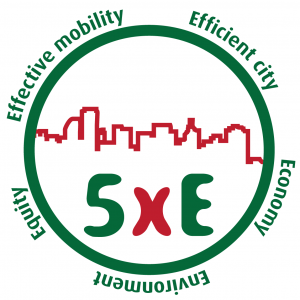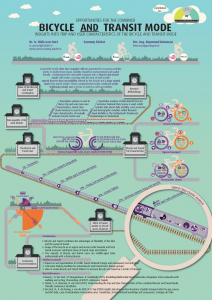Niels van Oort
Passenger Route Choice and Assignment Model for Combined Fixed and Flexible Public Transport Systems
The recent technological innovations have given rise to innovative mobility solutions. Public transport systems combining such services need novel models for the design of services. We develop a multimodal route choice and assignment model for combined use of line/schedule based public transport systems (fixed public transport) and demand responsive services (flexible public transport). The model takes into account the dynamic demand-supply interaction using an iterative learning model framework. Flexible public transport can be used to perform any part of the trip, ranging from a first/last mile service to an exclusive direct door-to-door connection. The developed model is implemented in an agent based simulation framework. The model is applied to the test network of Sioux Falls. Results, in terms of modal split, fleet utilization, and passenger waiting times are analysed for scenarios in which fixed and flexible public transport are offered as competing modes as well as potential complementing modes.
Find the CASPT presentation HERE
Insights into factors affecting the combined bicycle-transit mode
The combination of bicycle and transit is an upcoming, sustainable multimodality. The flexibility of the bicycle combined with the speed and comfort of good transit can be a highly competitive alternative to the car. This study shows that many factors influence the uptake and attractiveness of the bicycle-transit combination. An in-depth literature review resulted in over thirty unique factors: six transit related factors, twenty first-last mile factors and fifteen context related factors. All these factors might influence the demand for this ‘new’ mode positively or negatively. An exploratory choice modelling study showed that Dutch bicycle-train users in our sample are willing to pay €0.11 for a minute less bicycle time, €0.08 for a minute less train time, €0.11 for a minute of less time to park and €0.60 per avoided transfer. These kinds of insights give the bicycle and transit sector valuable information to be used in modelling multimodality and cost-benefit analyses, thereby supporting improved decision making and integrated design of bicycle and transit networks.
Read the full CASPT paper HERE and find the presentation HERE
Van B naar Anders
Op woensdag 30 mei organiseerde de Rli naar aanleiding van zijn advies een symposium. Tijdens dit symposium is het advies toegelicht en met betrokkenen uit de mobiliteitswereld besproken. Daarbij wordt stilgestaan bij de toekomst van mobiliteit en infrastructuur, de bestuurlijke praktijk en bij innovatie en verduurzaming van ons mobiliteitssysteem.
Vind alle bijdragen en verslag HIER
De presentatie over de toekomst van mobiliteit van Niels van Oort vind je HIER
Wat gaat MaaS ons brengen?
MaaS congres 2018: Niels van Oort is assistant professor public transport aan de TU Delft en doet onderzoek naar de effecten van nieuwe vervoerssytemen. Hij gaat de mogelijke impact van MaaS op reizigers en maatschappij toelichten, met voorbeelden van verschillende pilots en onderzoeken.
Zie HIER zijn bijdrage aan het MaaS congres 2018
Assessing and improving operational strategies for the benefit of passengers in rail-bound urban transport systems
Unplanned disruptions in transit can have consequent impacts on passengers. The more inconvenienced passengers are, the more likely operators will be negatively impacted. Yet so far, operators and researchers have addressed the rescheduling problem during disruptions mainly with a supply-side focus – timetable, crews and vehicles – and not with a passenger perspective. Urban rail transit particularly lacks insights in terms of passenger- focused rescheduling. Being able to assess the inconvenience experienced by passengers during disruptions compared with what they normally experience, and being able to compare how different rescheduling strategies affect them are therefore two major challenges.
The framework developed in this study precisely aims at tackling 8 these challenges. A case study of the metro of Rotterdam is used to test the framework developed in this paper. Alternative strategies are developed focusing on the incident phase (from the beginning of the incident until its cause is resolved). The application of the framework reveals that a regularity-focused rescheduling strategy would be beneficial for high-frequency service users. Realistically, yearly savings could amount to around €900,000 in terms of societal passenger costs for the operator in the Rotterdam area alone. However, the omnipresence of the punctuality paradigm, through which most operators plan and analyze operations, makes the implementation of passenger-focused strategies a challenging task for traffic controllers. The results of the study are valuable for transit operators worldwide and the framework can provide insights to decision-makers on the performance of different strategies, bringing to light trade-offs between supply and passenger sides during disruptions.
Read more of this research by Anne Durand: Paper TRB and Poster TRB
The Potential of Demand Responsive Transport as a Complement to Public Transport
Demand Responsive Transport (DRT) offers a collective flexible travel alternative that can potentially complement Fixed Transit (FT). The combination of an on-demand and line-based services holds the promise of improved mobility and increased service coverage. However, insofar it remains unknown whether DRT services deliver such much anticipated improvements.
This study presents an assessment framework to evaluate the performance of DRT and related changes in accessibility and performs an empirical analysis for a recently introduced DRT service in the Netherlands. The framework includes a performance benchmark between DRT and FT based on the computation of generalized journey times of the DRT rides and the FT alternatives, and it can help identify whether DRT is used as complement or substitute of FT.
The framework covers the spatial and temporal dimensions, and the explicit consideration of rejected trips is an integral part of the evaluation. Results suggest large accessibility improvements for DRT users, especially for some underserved origin-destination pairs.
Read more of this work of Maria J. Alonso Gonzalez: TRB Paper and TRB Presentation
Nieuwe lessen over de potentie van Fiets en OV
Het combineren van fiets en openbaar vervoer is een duurzame oplossing voor de (mobiliteits)uitdagingen in zowel stedelijke gebieden als daarbuiten. Er is een revival van de fiets gaande en ook hoogwaardig openbaar vervoer rukt op. De keten van fiets mét openbaar vervoer combineert de voordelen van beide systemen: De fiets zorgt voor fijnmazige ontsluitingen van herkomst en bestemmingen, is milieuvriendelijk en stimuleert een gezonde leefstijl. Voor wat betreft OV neemt de kwaliteit de laatste jaren sterk toe door de introductie van hoogwaardig OV (HOV): snelle, frequente en betrouwbare bus- tram- en metrolijnen met een hoog comfortniveau. Voorbeelden zijn R-Net, Randstadrail en Q-Link. De halteafstanden van deze systemen zijn relatief hoog, waardoor de fiets een belangrijke rol speelt in de gebiedsontsluiting.
Om het succes van de fiets en OV verder uit te bouwen is kennis nodig over hoe de mobilist zich nu en in de toekomst beweegt: Wat zijn de succesfactoren, welke voorwaarden spelen een rol en waarom worden bepaalde keuzes gemaakt, bijvoorbeeld. Dit paper laat de resultaten zien van vier TU Delft onderzoeken op dit gebied. Belangrijkste, nieuwe inzichten zijn bijvoorbeeld dat het invloedsgebied van HOV haltes tot 4x groter is ten opzichte van “gewoon’’ OV. Verder blijkt dat treinreizigers bereid zijn ca. 6 min. extra te fietsen naar een station waar ze een directe trein kunnen nemen naar hun bestemming (in plaats van met een overstap). Tot slot blijkt dat de huidige groep fiets-OV’ers in te delen is in 7 groepen, waarvan de middle-aged male professionals de grootste zijn en de gepensioneerden de kleinste. De resultaten zijn de basis voor verder onderzoek en toepassing om te komen tot een optimaal Fiets-OV netwerk.
Lees het hele CVS paper HIER
De presentatie is HIER beschikbaar
Opportunities for the Combined Bicycle and Transit Mode
Around the world cities face negative effects generated by increasing mobility needs. To tackle these issues, mobility should be environmental and spatial friendly. Combining bicycle and public transport into a ‘bicycle + transit mode’ will create a synergy with the best of both worlds: superb door-to-door accessibility offered by the bicycle and a large spatial reach from transit modes. These complemented modes combined easily challenge private carsin terms of speed as well accessibility.
Research regarding the users and trip types of the bicycle and transit mode is largely missing. This is unfortunate, since understanding both user and trip characteristics is of the utmost importance to improve the share of the bicycle and transit mode. Policy-makers can make concrete decisions on infrastructure and service investments only when the gap between the aforementioned societal need and scientific knowledge is filled.
The main analysis in the study is based on data from the Netherlands. The Netherlands is one of the countries with a head start regarding the use of the bicycle + transit mode. A one-day trip diary survey, representative of the population of the Netherlands, with more than 250,000 respondents who made nearly 700,000 trips over the course of 6 years (2010-2015), is used to derive important trip and user characteristics of the bicycle + transit mode. Finally, latent class cluster analysis is applied to find prototypical users of this mode on the basis of their socio-demographic attributes.
It is, for example, found that the most important purposes of the bicycle and transit mode are work or education, typically involving relatively long distances. Bicycle and transit-potential for other transit network levels, such as metros and bus rapid transit can be found. Moreover, seven unique user groups – from middle-aged professionals to school children – are identified, and their different travel behaviour is discussed.
The wider benefits of high quality of public transport for cities
The full value of public transport is often underestimated. The 5E framework, consisting of effective mobility, efficient city, economy, environment and equity supports assessing and quantifying this value. This paper presents the framework and a wide selection of sources illustrating the wider benefits of high quality of public transport for cities.
Find our ETC conference paper HERE

Vacancy: PhD: Public Transport Data Analysis & Modelling
We are looking for a new PhD candidate in our PT research team. Click on the vacancy below or check HERE


